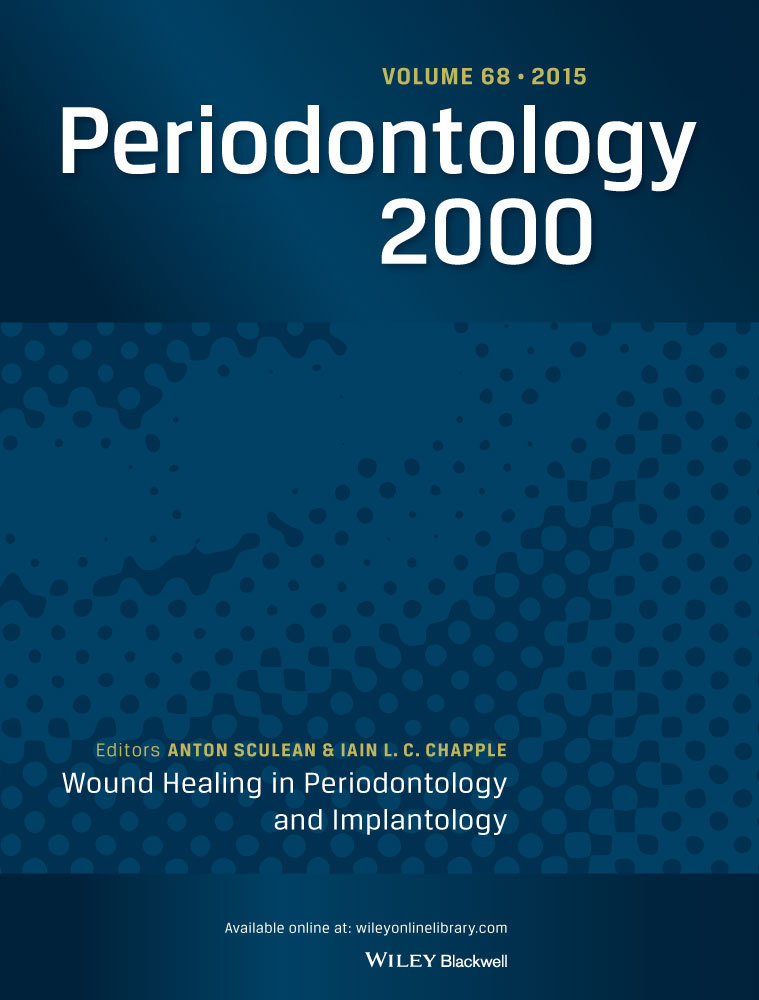Clinician‐ and patient‐reported outcomes following the surgical treatment of single gingival recession defects: A systematic review
IF 15.7
1区 医学
Q1 DENTISTRY, ORAL SURGERY & MEDICINE
引用次数: 0
Abstract
To analyze the effect of root coverage surgical therapy for the treatment of single gingival recession defects (GRD) in terms of clinician‐ and patient‐reported outcomes (CROs and PROs), with an emphasis on esthetic perception. The protocol of this PRISMA 2020‐compliant systematic review was registered in PROSPERO (CRD517050). Relevant articles reporting the outcomes of randomized controlled trials (RCTs) were identified through a literature search. After final article selection, according to specific eligibility criteria, data were extracted and categorized. Primary outcomes were clinician‐reported root coverage esthetic scores (RES) and patient‐reported esthetic perception and satisfaction using different assessment methods, such as standardized visual analog scales (VAS). Data were analyzed and the risk of bias in all included studies was assessed. Fifty‐eight articles pertaining to 50 different RCTs were selected. A total of 1820 subjects presenting 2219 single GRDs were treated. Key findings derived from the pooled estimates indicated that root coverage and gingival phenotype modification therapy positively influenced both RES and patient‐reported esthetic perception and satisfaction values. Compared to the use of a coronally advanced flap (CAF) alone (i.e., monolaminar technique), the use of a CAF in conjunction with a subepithelial connective tissue graft (i.e., bilaminar technique) had a positive impact on both RES and VAS values, whereas CAF in conjunction with soft tissue substitutes only had a beneficial effect on VAS values. Surgical approaches based on lateral flap displacement were associated with superior mean RES values compared to techniques involving coronal flap displacement. Meta‐regression analyses revealed a statistically significant positive association between mean root coverage and RES (i.e., the greater the percentage of root coverage, the higher the RES). Conversely, the association between patient‐reported esthetic perception and MRC was not statistically significant. In addition, it was observed that dentinal hypersensitivity can be substantially reduced with surgical root coverage therapy, regardless of the treatment modality. Surgical therapy for the correction of single GRDs had a positive effect on both clinician‐reported esthetic scores and patient‐reported esthetic perception and satisfaction. Bilaminar techniques are generally associated with superior results.临床医生和患者报告的单牙龈退缩缺陷手术治疗后的结果:一项系统回顾
从临床医生和患者报告的结果(cro和PROs)方面分析根覆盖手术治疗单纯性牙龈萎缩缺陷(GRD)的效果,重点是审美感受。本次符合PRISMA 2020‐标准的系统评价方案已在PROSPERO注册(CRD517050)。通过文献检索找到报道随机对照试验(RCTs)结果的相关文章。在最终的文章选择之后,根据具体的入选标准,对数据进行提取和分类。主要结果是临床医生报告的牙根覆盖美学评分(RES)和患者报告的审美感知和满意度,采用不同的评估方法,如标准化视觉模拟量表(VAS)。对所有纳入的研究进行数据分析和偏倚风险评估。共选择了50篇不同rct的58篇文章。共有1820名受试者出现2219例单次GRDs。综合估计得出的关键发现表明,牙根覆盖和牙龈表型修饰治疗对RES和患者报告的审美知觉和满意度都有积极影响。与单独使用冠状进展皮瓣(CAF)(即单层技术)相比,CAF与上皮下结缔组织移植物(即双层技术)联合使用对RES和VAS值均有积极影响,而CAF与软组织替代品联合使用仅对VAS值有有益影响。与冠状皮瓣移位的手术方法相比,基于外侧皮瓣移位的手术方法具有更高的平均RES值。Meta回归分析显示,平均根系覆盖度与RES之间存在统计学上显著的正相关关系(即根系覆盖度百分比越大,RES越高)。相反,患者报告的审美知觉和MRC之间的关联没有统计学意义。此外,我们观察到,无论治疗方式如何,牙本质过敏都可以通过手术牙根覆盖治疗大大减少。手术治疗对单个GRDs的矫正对临床医生报告的美学评分和患者报告的审美感知和满意度都有积极的影响。双层技术通常具有较好的效果。
本文章由计算机程序翻译,如有差异,请以英文原文为准。
求助全文
约1分钟内获得全文
求助全文
来源期刊

Periodontology 2000
医学-牙科与口腔外科
CiteScore
34.10
自引率
2.20%
发文量
62
审稿时长
>12 weeks
期刊介绍:
Periodontology 2000 is a series of monographs designed for periodontists and general practitioners interested in periodontics. The editorial board selects significant topics and distinguished scientists and clinicians for each monograph. Serving as a valuable supplement to existing periodontal journals, three monographs are published annually, contributing specialized insights to the field.
 求助内容:
求助内容: 应助结果提醒方式:
应助结果提醒方式:


